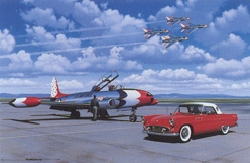|
|
| T-Birds |
|
 |

|
 |
|
|
| DESCRIPTION |
 |
| 16 x 11.5 Inch Collector Size Unframed Lithograph $40.00
In his very nostalgic mid-fifties painting appropriately entitled "T-Birds" highly-acclaimed aviation artist Stan Stokes portrays a 1955 Ford Thunderbird on the tarmac next to a T-33 "T-Bird" jet trainer while four USAF Thunderbirds roar by over head flying their F-100C's. The 1955 Ford Thunderbird was Ford's response to the introduction in 1953 of the Corvette by General Motors. The Thunderbird incorporated a powerful V-8 engine compared to the Corvette's 6 cylinder power plant and with its contemporary styling the Thunderbird outsold the Corvette in 1955. Late in 1955 Ford made the distinctive porthole removable hardtop available solving the poor visibility problem encountered with the original hardtop. The 1955 Ford Thunderbird is generally acknowledged to be one of the ten most significant American automobiles introduced in this century. The T-33 was the USAF's first jet trainer designed from the start as a training aircraft. Nearly 6000 T-33 "T-Birds" were produced and this reliable aircraft remained in service for more than forty years. The T-33 first flew in 1949 and production by Lockheed continued until 1959. The T-33 was derived from the F-80 "Shooting Star" and became Lockheed's second biggest selling aircraft second only to the P-38 "Lightning." The T-33 was approximately 38 feet in both length and wingspan and was capable of speeds of around 550 MPH. There were very few military pilots in the U.S. between 1955 and 1980 which did not have some time in a T-33. The two seat T-33's as depicted in Mr. Stokes painting were often utilized for VIP flights for journalists prior to USAF Thunderbird performances. The F-100 also nicknamed the "Hun" debuted in 1953. The F-100 was designed from the onset as a supersonic fighter. Initial flight testing revealed instability at supersonic speeds and modifications were made to the initial production models which included larger wingspan and larger fin and rudder areas. The F-100C's shown in Mr. Stokes painting were flown by the USAF Thunderbird precision flying team for several years. The "C" model was the fastest of all Super Sabres although the "D" model was produced in the largest numbers with nearly 1300 being produced. The Super Sabre was equipped for aerial refueling a novelty at the time but something which became mandatory for future generations of jet combat aircraft. |
|


|